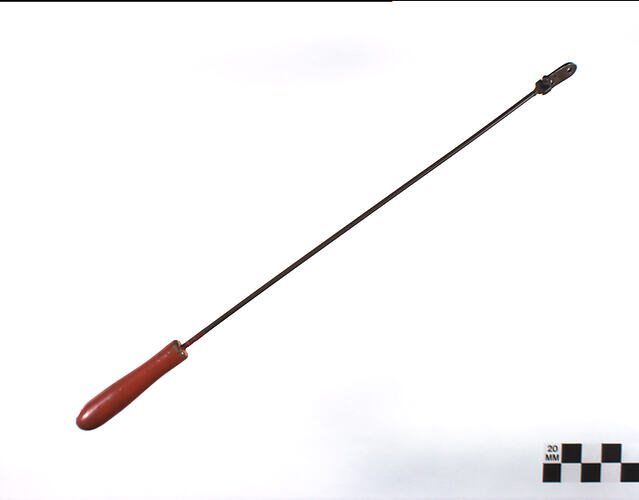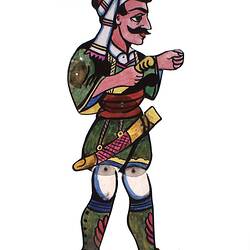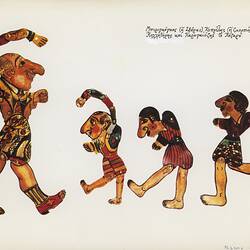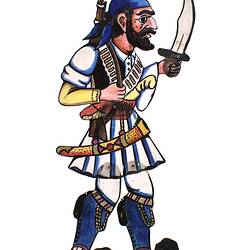Summary
Alternative Name[s]: Yiristari
This puppet rod was commissioned in the 1950s by the Greek puppeteer and popular artist Abraam (Antonakos). It was made by a gypsy in Egaleo, a suburb of Athens, where he had set up camp with other gypsies who made various goods out of iron and cane or reed. Abraam used the puppet rod to manipulate his puppets during performances in Greece from the 1950s when he set up his own stage. This and most of the puppets and accessories in the collection were brought to Australia by Abraam Antonakas for his performances at the Astor Theatre in Melbourne in 1977. He then left the collection with Dimitri Katsoulis who used them in all his subsequent performances in Victoria and in South Australia from 1978 to 1991. Dimitri Katsoulis migrated to Australia in 1974 to escape a regime that repressed Greek artists. He had trained in Greece with theatre and film companies as an actor and technician. A master of the traditional Greek shadow puppet theatre, his performances explored contemporary issues such as the isolation of migrant women and children. Unable to obtain funding and support, he returned to Greece in 1991, leaving his entire collection to the people of Victoria. It includes 32 shadow puppets and around 170 props, set backdrops and technical tools and stage equipment. Dimitri has since returned to Melbourne and assists the Museum to continue to document this rich art form within both local and international contexts.
The puppet rod is integral to all performance of traditional Greek Shadow Puppet Theatre.The puppet rod is fitted to the shoulder of the puppet (and also the hand of the long arm of the character Karaghiozis) so that the puppeteer can move it around the stage on the screen. The puppet rod is the most basic tool used by the puppeteer. Until 1924 the puppet was nailed to a wooden rod approximately 50cm long with which it was manoeuvred around the stage. It had one basic disadvantage in that the puppet couldn't be flipped to exit the stage, so the puppet exited the stage by walking off backwards. Due to this limitation, in order for the puppet to respond to or commence dialogue with another puppet standing behind it, the puppeteer would lean the top part of the puppet backwards. Due to this shortcoming, the puppeteer's assistants that affixed the rods to the puppets had to know the play well to know which way the puppet entered or exited the stage during the performance so they could affix it facing the correct way. This type of rod was used by all Karaghiozis puppeteers in the Art of Shadow Puppet Theatre, and although the wooden rods did evolve over time to enable the puppet to be flipped around, everything changed in 1924 with the puppeteer Lefteri Kelarinopoulos' discovery of the rivet. The puppets were finally able to be manoeuvred in any direction. The rods in the Museum's collection are the final form of the puppet rod created by puppeteers. It is smaller and perfected and permanently incorporates the metal hinge control on one end and a wooden handle on the other end which it is held by the puppeteer.
Information supplied by Greek Shadow Puppet Theatre master Dimitri Katsoulis, 2007.
Physical Description
A metal rod with a turned wooden handle at one end, painted red. The other end of the rod has been flattened and has a hinged, double- leaved flap attached. There is a small hole in each "leaf", which fits around similarly sized holes in the puppets. A screw, fastened with a nut, attaches the rod to the puppet.
Significance
This collection of puppets, props, stage sets, and technical tools and equipment relating to traditional Greek Shadow Puppet Theatre is unique in Australia and rare in international public collections. The history of Greek Shadow Puppet Theatre, its puppet characters and the methodology of its performance has been recorded in partnership with the puppet master to whom the collection belonged. The collection is highly significant both as documentation of an important cross-cultural, centuries-old art form, and as an example of the transnational migration of cultural activity between Greece and Australia. It is a collection which was created and performed in Greece and Australia from the mid to late twentieth century, by two puppet masters, who transported the tradition between two countries. Abraam Antonakos came to Australia in 1977 to perform the puppet theatre and then deposited the puppets with Dimitri Katsoulis, who had migrated to Australia in 1974. Dimitri's story becomes one of migration experience, cultural maintenance and adaptation, and finally return migration and the discontinuance of this cultural art form in Australia.
More Information
-
Collection Names
-
Collecting Areas
-
Acquisition Information
Purchase
-
Commissioned By
-
User
-
User
-
User
Mr Dimitri Katsoulis, Australia, 1978-1991
Dimitri was given the puppet by Abraam in 1977 and then used it in his performances in Australia until 1991. -
Classification
-
Category
-
Discipline
-
Type of item
-
overall dimensions
3 cm (Length), 59 cm (Width), 3 cm (Height)
-
Exhibition Collection Management
30 mm (Length), 590 mm (Width), 30 mm (Height)
-
References
[Link 1] Malkin, Michael, R. Traditional and Folk Puppets of the World, A.S. Barnes & Co., Inc., N.J., 1977; Simmen, Rene, The World of Puppets, Elsevier, Phaidon, London, 1975; Hogarth, Ann & Bussell, Jan, Fanfare for Puppets!, David & Charles Publishers Ltd, USA, 1985; Yayannos, A & Ar and Dingli, J. The World of Karaghiozis, 1976
-
Keywords
Cultural Maintenance, Greek Communities, Greek Immigration, Karaghiozis Theatre, Shadow Puppetry, Theatres, Working Life



